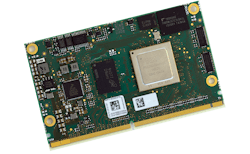SOM Sports Safety SoC for Automotive Apps
One of the fastest growing areas in electronics is the automotive space, where incorporating the latest silicon is a crucial factor in addition to implementing safety and security. MicroSys Electronics (distributed by Eurotech in the U.S.) is delivering NXP’s new S32G2 system-on-chip (SoC) in a compact system-on-module (SOM) form factor. The miriac MPX-S32G274A module (Fig. 1) wraps solid-state storage around the high end, NXP AEC-Q100 Grade 2 (−40 to 105°C) qualified S32G274 processor.
The module is designed to meet ASIL-D requirements as well as functional-safety standards comparable to IEC 61508. This includes standards like EN 50155 for railway technology, aviation’s DO-160, ISO 13849 for stationary and mobile machinery, ISO 10218 that addresses manufacturing robots, IEC 62061 control systems, and IEC 61800-5-2 drive systems.
The module includes 4 GB of LPDDR4 DRAM as well as 16 GB of eMMC non-volatile storage and 64 MB of QSPI flash memory. The MPX-S32G274 is built around a 1-GHz, quad-core, Arm Cortex-A53 complex with Arm Neon technology. These cores are split into two clusters that can operate in lockstep mode. The SoC also has triple, dual-core lockstep Arm Cortex-M7 cores to handle real-time applications. The Cortex-A53 cluster supports hypervisors and operating systems such as Linux. In addition, MicroSys supports FreeRTOS for the Cortex-M7 cores.
The SoC is designed for gateway operation including the zonal automotive gateway approach that’s becoming more popular for automotive applications. The array of networking interfaces (Fig. 2) allows the chip to act as a gateway between a wide variety of devices and networks. It supports time-sensitive networking (TSN) for the Ethernet ports and CAN FD and Flexray also are designed for real-time applications.
Networking accelerators offload the host process. This includes a Low-Latency Communication Engine (LLCE) and a Packet Forwarding Engine (PFE). The SoC incorporates a Hardware Security Engine (HSE) with secure boot support. The HSE provides a comprehensive root of trust and handles encrypted data transfers over its many networks.
The SOM is suitable for use in end products as well as for prototyping.
About the Author
William G. Wong
Senior Content Director - Electronic Design and Microwaves & RF
I am Editor of Electronic Design focusing on embedded, software, and systems. As Senior Content Director, I also manage Microwaves & RF and I work with a great team of editors to provide engineers, programmers, developers and technical managers with interesting and useful articles and videos on a regular basis. Check out our free newsletters to see the latest content.
You can send press releases for new products for possible coverage on the website. I am also interested in receiving contributed articles for publishing on our website. Use our template and send to me along with a signed release form.
Check out my blog, AltEmbedded on Electronic Design, as well as his latest articles on this site that are listed below.
You can visit my social media via these links:
- AltEmbedded on Electronic Design
- Bill Wong on Facebook
- @AltEmbedded on Twitter
- Bill Wong on LinkedIn
I earned a Bachelor of Electrical Engineering at the Georgia Institute of Technology and a Masters in Computer Science from Rutgers University. I still do a bit of programming using everything from C and C++ to Rust and Ada/SPARK. I do a bit of PHP programming for Drupal websites. I have posted a few Drupal modules.
I still get a hand on software and electronic hardware. Some of this can be found on our Kit Close-Up video series. You can also see me on many of our TechXchange Talk videos. I am interested in a range of projects from robotics to artificial intelligence.



